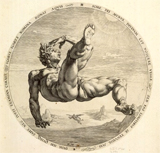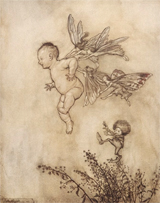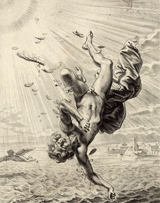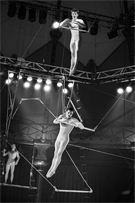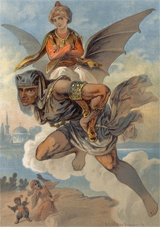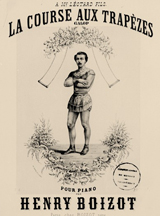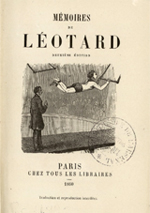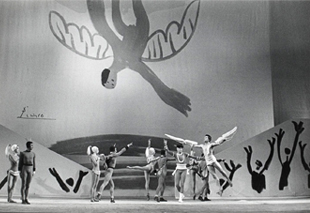by Pascal Jacob
The most amazing aerial artist of all is, perhaps, the hero of a famous tale published in 1911 by the Scottish author JM Barrie; the story of a child who refuses to grow up and who haunts Neverland, the “Imaginary Land” where pirates, crocodiles and the lost boys also live... Peter Pan embodies our fascination for the lightness and ease it takes to flutter over cities and through time; an amusing analogy when we compare it with the image of Jules Leotard, a real-life trapeze artist, flying over the roofs of Paris on a lithograph inserted in his so-called "memoirs"...
Leotard represents this desire of being detached from the ground, a feeling that is freely embodied by all those who launch themselves from one trapeze to another, and his popularity is immense. One could almost allude to an unprecedented cult surrounding this man of graceful physique who was much sought after by a multitude of admirers, so much so that a small book was dedicated to them, detailing precisely all of Leotard’s conquests and the gifts his admirers offered him. A number of musical pieces were dedicated to him, including a Léotard Waltz composed by Charles Coote Junior and the Leotard Polka by Charles Haring. The trapeze artist is also celebrated in a song, The Daring Young Man on the Flying Trapeze performed by the famous singer George Leybourne. The Russian director and choreographer Valentin Gneoushev prolonged this fascination by creating his Homage to Léotard in 1993, an act where the founding techniques of the discipline, flying from bar to bar and from the bar to the catcher, are presented one after the other. Leotard, who left us prematurely, has become a member of a mythical line of descent where the figures of Icarus and Phaeton, who died because of their desire to fly, flourish, one dropped by his wings and the other carried away by the ardour of his horses flying above the world and who fell "victim to a noble audacity" according to the epitaph that the Naiads carved on his grave. In both cases, it was the sun’s rays that proved fatal to the heroes of an uncontrolled flight, which is very evocative of the cultural basis of this desire to free oneself from one’s earthly constraints: freedom, a new perspective, an emancipation from our daily routines, escaping and controlling one's own destiny.
Flight and Civilisation
The hero of Vertigo, Paul Auster’s dizzying fable which is strangely believable and therefore particularly captivating, was buried for several days in order to free himself from his attachments with the earth, thereby becoming capable of rising above the ground... The writer explores the detachment from oneself, the possibility of absolving oneself from one’s everyday weight in order to acquire such a lightness that flying becomes natural. This diligence to the mastery of the air and the void, coupled with an eternal appetite for the absolute freedom of the birds, permeates the imagination of authors and leads them to explore unforeseen areas. The adventures of JK Rowling’s little wizard would probably not be the same if its heroes did not have the ability to fly fast and high by riding simple brooms... This magical dimension nurtures the collective imagination and it is most certainly not a coincidence that trapeze artists often come in first in all public "opinion polls". This propensity to fly over the world is shown transversally in many cultures, including such characters as Aladdin or Sinbad, flying carpet enthusiasts who partake in spectacular flights with or without the help of a genie!
If these figures remain so powerful throughout every generation, it is because they display an insolent ability to play with the known and accepted limits, transforming themselves into fables that have been adored since the Thousand and One Nights. The principle of ascension and that of falling, which is considered as its inevitable consequence, appear across many civilizations all the while acutely and simply illustrating this ever-unsatisfied desire to rise far above the crowd.



